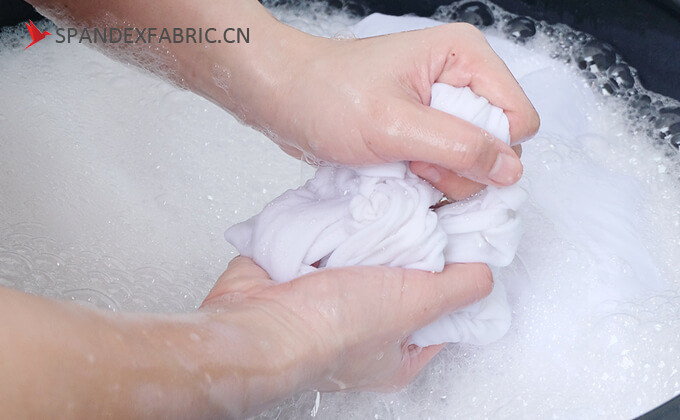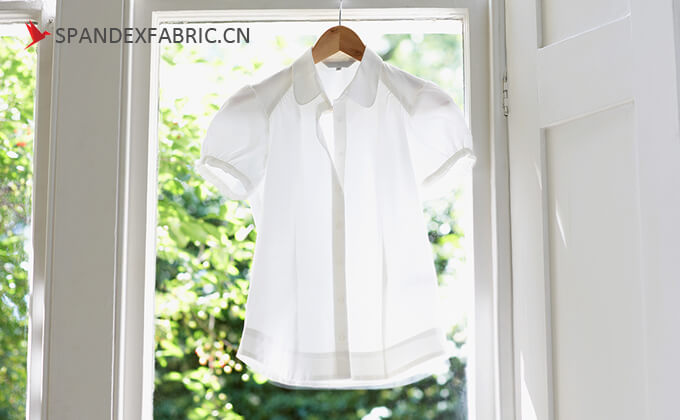Many customers have a slight concern when doing functional finishing of fabrics, worrying that it will greatly affect the shrinkage of fabrics. In fact, if the shrinkage of the fabrics have been well controlled and within the qualified range, the finishing will basically have no further effect on the shrinkage of fabrics. Here we come together to understand the shrinkage of fabrics.
Synthetic fibers and blended textiles have the minimum shrinkage rate, followed by woolen fabrics, hemp fabrics, cotton fabrics, silk fabrics have a larger shrinkage, while the largest ones are viscose fiber, rayon, rayon fabrics.
From an objective point of view, cotton fabrics have more or less the problem of shrinkage and fading, with the key being the finishing afterwards. So the general home textile fabrics are pre-shrinking processed.
It is worth noting that pre-shrinkage processing is not tantamount to no shrinkage, but instead means that the shrinkage rate is controlled within GB standard of 3%-4%. Fabrics, especially natural fiber fabrics, will shrink. Therefore, it is important to know the shrinkage rate of the fabric, in addition to the quality, color and pattern of the fabric, when purchasing fabrics.

I. The effect of fiber and knitting shrinkage
When fibers absorb water, a certain degree of swelling occurs. Usually, the swelling of fibers is anisotropic (except nylon), which means that the length is shortened and the diameter is increased. The difference between the length of the fabric before and after washing and the percentage of its original length is usually called the shrinkage rate. The stronger the water absorption capacity, the more intense the swelling, the higher the shrinkage rate, the worse the dimensional stability of the fabric.
The length of the fabric itself is different from the length of the yarn (thread) used, and the difference between the two is usually indicated by the knitting shrinkage rate.
Knittng shrinkage (%) = [yarn(thread) length – fabric length] / fabric length
After the fabric is put into the water, the fabric length is further shortened due to the swelling of the fiber, resulting in shrinkage. Fabric knitting shrinkage rate is different, so is the shrinkage rate. The fabric’s own structure and knitting tension is different, so its knitting shrinkage rate is also different. With lower knitting tension, the fabric is tight and thick, and the knitting shrinkage rate is large, and the shrinkage rate of the fabric is low; with higher knitting tension, the fabric is light and loose, and the knitting shrinkage rate is small, and the shrinkage rate of the fabric is high. In the dyeing and finishing process, in order to reduce the shrinkage rate of the fabric, often use the pre-shrinkage process to increase the weft density, to improve the knitting shrinkage rate in advance, so as to reduce the shrinkage rate of the fabric.
II. The causes of shrinkage.
(1) When spinning,knitting and dyeing, the yarn and fiber in the fabric are stretched or deformed by the external force, and the yarn and fiber and fabric structure produce internal stress in the static dry relaxation state, or static wet relaxation state, or in the dynamic wet relaxation state, full relaxation state, the release of different degrees of internal stress, so that the yarn,fiber and fabric back to the initial state.
(2) Different fibers and their fabrics have different degrees of shrinkage, mainly depending on the properties of their fibers – hydrophilic fibers have a greater degree of shrinkage, such as cotton, linen, viscose and other fibers; hydrophobic fibers have a lower degree of shrinkage, such as synthetic fibers.
(3) When the fibers are moistened, they swell under the influence of liquid, increasing the diameter of the fibers, forcing the radius of curvature at the interweaving point of the fabric increases, resulting in a shortening of the length of the fabric. For example, cotton fibers in the role of water expansion, cross-sectional area increased by 40 ~ 50%, the length increased by 1-2%, while synthetic fibers are shrinkage to heat, such as boiling water shrinkage, etc., generally about 5%.
(4) Under the heat conditions, the shape and size of the fiber change and shrink. After cooling down, it also cannot return to the initial state, known as fiber thermal contraction. The percentage of length before and after thermal contraction is called thermal contraction rate. Generally, it is measured by 100℃ boiling water contraction test. It is also measured by hot air, the percentage of contraction in hot air at over 100℃, and also by steam, the percentage of contraction in steam at over 100℃. Fibers also perform differently under different conditions such as internal structure, heat temperature and time.For example, the boiling water shrinkage of processing polyester staple fiber is 1%, while vinylon is 5%, and the team shrinkage of polyvinyl chloride is 50%.
There is a close connection between fiber processing and the dimensional stability of its fabric, which provides some basis for the design of the post-process.
III. The shrinkage rate of common fabrics
Cotton 4% – 10%.
Synthetic fiber 4% – 8%.
Cotton-polyester 3.5% – 5 5%.
White cotton fabric 3%
Blue Print Cloth 3-4%
Poplin 3-4.5%
Printed cotton fabric 3-3.5%
Twill 4%
Denim 10%$
Synthetic cotton 10%.

IV. Factors affecting the shrinkage rate
1. Raw materials
Fabric raw materials are different, so the shrinkage rate is varied. In general, the moisture-absorbent fibers swell after immersion, the diameter increases, the length shortens, and the shrinkage rate is higher. For example, some viscose fiber water absorption rate of up to 13%, while the synthetic fiber fabric moisture absorption is poor, and its shrinkage rate is low.
2. Density
The density of the fabric is different, and its shrinkage rate is also different. Such as warp and weft density is similar, its warp and weft shrinkage rate is also close. If the fabric warp density is larger than the weft density, the warp shrinkage is large, and vice versa, if the weft density of the fabric is larger than the warp density, the weft shrinkage is large.
3. Yarn thickness
With different fabric yarn thickness, the shrinkage rate is also different. Fabric with thick yarn count has a higher shrinkage rate, and fabric with fine yarn count has a lower shrinkage rate.
4. Manufacturing tech
With different production tech of fabrics, the shrinkage rate is also different. Generally, in the process of knitting and dyeing fabrics, the fibers are stretched multiple times, and the processing time is long. The shrinkage of the fabric with higher tension applied is higher, and vice versa.
5. Natural plant fibers (such as cotton, hemp) and recycled plant fibers (such as viscose) are easier to absorb moisture and swell compared to synthetic fibers (such as polyester, acrylic), so the shrinkage is higher. Wool, on the other hand, is prone to matting due to the scale structure of the fiber surface, which affects its dimensional stability.
6. Fabric structure
In general, the dimensional stability of woven fabrics is better than knitted fabrics; high-density fabrics are better than low-density ones.
In woven fabrics, the general shrinkage rate of plain fabrics is lower than that of flannel; and in knitted fabrics, the shrinkage rate of plain knitted structures is lower than that of ribbed fabrics.
7. Production process
As the fabric is dyed, printed and finalized, it will inevitably be stretched by the machine, thus there is tension on the fabric. However, the fabric is easy to release the tension after being exposed to water, so we will find the fabric shrinks after laundering. In the practical process, we generally use pre-shrinkage to solve this problem.
8. Washing and care process
Washing care includes washing, drying, and ironing, and each of these three steps affects the shrinkage of the fabric. For example, the dimensional stability of hand-washed samples is better than that of machine-washed samples, and the temperature of the wash will likewise affect its dimensional stability. In general, the higher the temperature, the less stable it is. The way the sample is dried also has a greater impact on the shrinkage of the fabric.
Commonly used drying methods are drip drying, flat laying, hung drying and rotary drying. Wherein the drip drying method has the least effect on the size of the fabric, while the rotary drying has the greatest effect, and the remaining two are moderate.
In addition, a suitable ironing temperature based on the composition of the fabric can also improve the shrinkage of the fabric. For example, cotton and linen fabrics can be ironed at high temperatures to improve their size shrinkage. But not the higher the temperature is better, for synthetic fibers, high temperature ironing can not improve its shrinkage rate, but will have damage to its performance, like fabric became hard and fragile.









